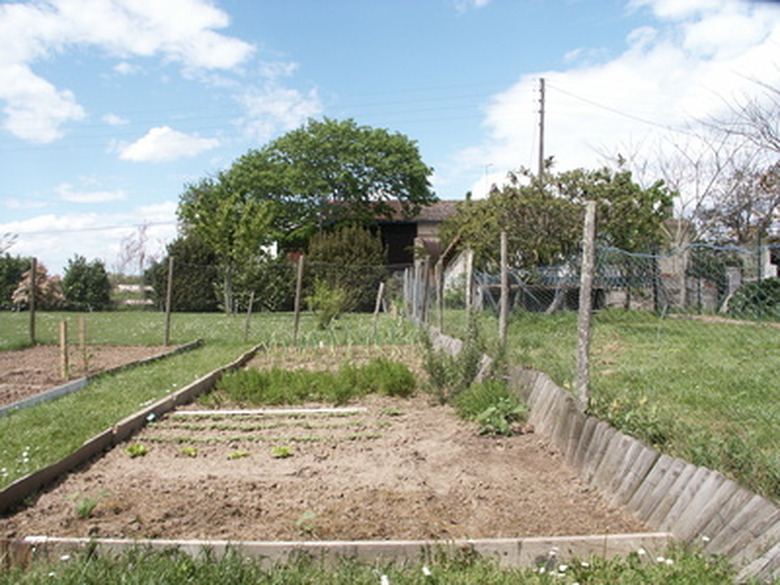Rototiller History
The modern walk-behind rototiller is such a common power implement in gardens and on small farms that many people assume it always has been in its modern form, with the curved steel tines either in front of or behind the small gas engine. The earliest rotary tillers, however, were massive machines, powered by a steam engine and pulled by a team of horses. The European-made Romaine Crosskill Digger appeared around 1857.
The Earth Grinder
The earliest practical rototillers, called "boden frasen" (earth grinders) were designed and built by German engineer Konrad Victor von Meyenburg. Self-propelled and the size of tractors, these machines used swinging choppers made from heavy steel wire. In 1909, von Meyenburg patented his spring-mounted tines. From 1912 to 1914, several prototypes were made and demonstrated in Europe and the United States.
- The modern walk-behind rototiller is such a common power implement in gardens and on small farms that many people assume it always has been in its modern form, with the curved steel tines either in front of or behind the small gas engine.
The First Small Rototiller
In October 1936, von Meyenburg was granted a German patent for a small rotary cultivator. It had one central wheel, at the front, but was not propelled by anything other than the rotating tines. The engine was mounted directly over the tines so that its weight would help to prevent the tines from pushing the cultivator out of the soil as they turned.
Manufacture Under License
Small rototillers were made under license, based on von Meyenburg's designs, by Siemens-Schuckert-Werke in Germany and the Simar Co. of Switzerland. Although they were well-made pieces of machinery, they did not fare well on rocky American soils, where tine breakage was a serious and constant problem.
The All-American Rototiller
C.W. Kelsey, an American auto manufacturer, opened an office in New York City in 1932, registered the name Rototiller and started importing the Siemens-Schuckert-Werke, Simar and Danish Tillavator machines. After a move to Long Island City, New York, and then to Troy, New York, Rototiller Inc. introduced its own tiller design in 1934, the Model AA All-American. It tilled an area 16 inches wide and 9 inches deep, and it was powered by a 1½-horsepower (HP) gas engine. In 1938, according to rototiller historian Donald A. Jones, the company introduced the larger and more powerful Model A-1, which had a 4½-HP engine.
- In October 1936, von Meyenburg was granted a German patent for a small rotary cultivator.
- After a move to Long Island City, New York, and then to Troy, New York, Rototiller Inc. introduced its own tiller design in 1934, the Model AA All-American.
Roto-Ette Tillers
By 1945, Rototiller Inc. had produced large tractor-mounted tillers and several smaller walk-behind models, but company officials decided to concentrate on small home garden tillers. The larger commercial machines were then made under license by Graham-Paige Motors Corp. In 1947, the Roto-Ette tiller sold for $360. The Model T came along in 1949, selling for $194.50, and the Model 2 and Model 3 machines were introduced in 1952.
Between 1940 and the mid-1970s, a wide variety of small tillers were introduced, including Gravely, Deere & Co., Sears, Roebuck, Choremaster, Yardman, Farm-Ette, Hahn, Rolle, Magna American, Merry, Penfield, Quick, Springfield and Seaman.
Troy-Bilt Rototillers
In 1959, the Porter Cable Co. bought a controlling interest in Rototiller Inc. and moved the company to Syracuse, New York, before selling it in 1960 to Rockwell Manufacturing Co. Rockwell soon decided to sell the company to a group of former Troy employees, who started their business under the name Watco Machine Products and produced the company's first tiller, the Trojan Horse. A trademark dispute in 1968 made the company change the product name to Troy-Bilt and to change the company name to Garden Way Manufacturing Co., which declared bankruptcy in 2001 and was purchased by MTD Products Inc.
- By 1945, Rototiller Inc. had produced large tractor-mounted tillers and several smaller walk-behind models, but company officials decided to concentrate on small home garden tillers.
- In 1959, the Porter Cable Co. bought a controlling interest in Rototiller Inc. and moved the company to Syracuse, New York, before selling it in 1960 to Rockwell Manufacturing Co. Rockwell soon decided to sell the company to a group of former Troy employees, who started their business under the name Watco Machine Products and produced the company's first tiller, the Trojan Horse.
